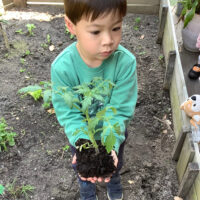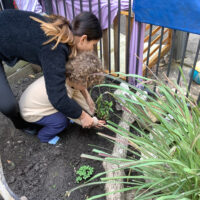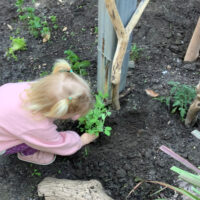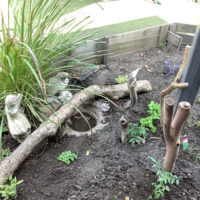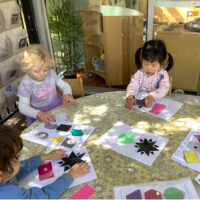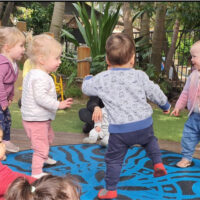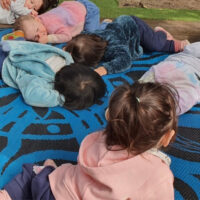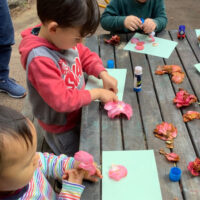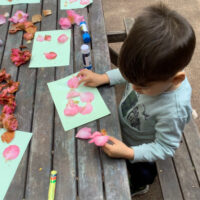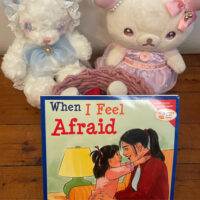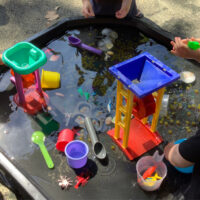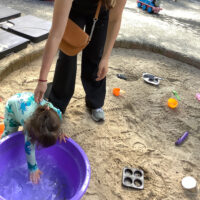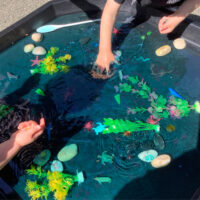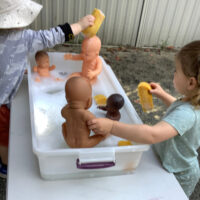Gorton House
Toddlers
Story by Educator Russell
Break out the weeding implements, ready the digging tools… spring has sprung, and the toddlers in Gorton House are garden-ready and hyped!
It’s that time of the year again when we create a new garden, learn about sowing seeds and seedlings and talk about how certain plants grow and how they help to keep us healthy. It’s a time when we get a chance to be a part of the cycle of nature, not to mention getting our hands dirty and digging holes… what more could a curious three-year-old want?
This year we inadvertently ended up with a garden of two halves, with one half having a bit of a Mediterranean vibe and the other having a bit more of an exotic Southeast Asian feel.
With the help of some very curious and deeply immersed assistants, we managed to create a space of immense potential and one that the children will play an active part in maintaining. Stay tuned!
Johnson House
Toddlers
Story by Educator Emily
Shapes are part of our everyday world and the children in Johnson House toddlers often identify different shapes during their play. They are showing curiosity as they begin to learn the names of shapes and their characteristics, such as how many sides they have. Our Educators have been supporting this learning by offering a range of opportunities for the children to extend on their knowledge.
A recent shape-matching game set up by an Educator helped the children to identify shapes and engage in a discussion about where they may have seen these shapes in the environment. The children were keen to chat about this as they played. Our Educators observed the children growing their understanding and increasing their confidence as the matching game progressed.
Murray House
Infants
Story by Educator Tripti
The children in Murray House infants show a huge interest in music, particularly when they hear the ‘Freeze Song’ and the ‘Sleeping Bunny Song’.
Recently when the music was put on, the children stopped whatever they were doing and started doing the actions of lying down, hopping up and down and stopping and freezing in place. The children could be seen clapping along to the songs and moving around to the music. These experiences are fantastic opportunities for the children to develop a love of music while building the skills to help them follow rhythms. These particular songs also provide clear instructions for the children to follow, helping them to develop their listening and comprehension skills.
Toddlers
‘Spring Has Sprung’
Story by Educator Holly
In Murray House toddlers we recently celebrated the beginning of spring by making some gorgeous flower collages. We went for a walk and collected some pretty pink flowers from out the front of the reception office and brought them back to our friends. The children pulled the petals off the flowers and stuck them to the paper. They took their time, placing each petal so delicately, being careful not to rip them.
It was a lovely way to recognise the beginning of a new season and the children were developing an appreciation for the beauty of nature as they admired the wonderful pink tones on their artworks.
Robinson House
Story by Educator Denise
Recently the children in Robinson House engaged in a pretend play picnic combined with a literacy experience, as part of National Child Protection Week (NCPW). We read ‘Be Careful and Stay Safe’, by Cheri J Meiners, which is a book from the ‘Learning to Getting Along®’ series. The story helped us to continue our discussions about how we feel safe with people we trust and who care for us. In addition, we also talked about people who work in special jobs that help other people, such as police officers, fire fighters, religious leaders and teachers. This made the children reflect on how we, the Educators at The Infants’ Home, help keep them safe such as by giving them guidance and feedback and supervision.
After the story, the children attended a picnic with a teddy bear theme. I included ten teddy bears, and a plethora of felt goodies such as strawberries, blueberries and macarons to made up our spring picnic feast. It was a great opportunity for the children to exercise their patience while the picnic was being set up. During the picnic, the children engaged in sharing and negotiating the toys and the pretend food, enriching their social interactions with positive gestures and appropriate communication. This experience also further developed their problem-solving skills in relation to navigating social situations and discovering various ways to play with the resources.
It was very tricky for some children to share their favoured resources but, in the end, they learned about compromise and realised that patience is a virtue we can practice continuously. This was compounded by me using a visual timer to help the children understand the concept of time and further develop their turn taking skills. The children were keen to engage in different peer groupings, creating and maintaining meaningful social connections and giving them opportunities to enact their ideas and theories in play. This also allowed the children to discern how to enter and exit play with different peers on their own accord.
The children were careful with the delicate felt strawberries, macarons and blueberries and combined these to create cupcakes and other food combinations. The teddy bears were also frequently exchanged, indicating their popularity. The children expressed their caring and nurturing behaviours through cuddling and giving the toys hugs. The atmosphere was warm and merry as the children and I played together to make this spring picnic enjoyable for everyone.
Community Playgroups
Story by Playgroup Coordinator Rebecca
The warmer weather that we have been experiencing lately is the perfect excuse and opportunity at Playgroup for us to spend time splashing and learning with water. We all know how much most children love to play with water, and it not only helps to keep them cool on hot days, but also has many amazing benefits for childhood development. Water play usually involves a water table or large tub that children can stand around together and this is the perfect setting for social experiences as they splash, play and have fun.
Water play helps to develop children’s hand-eye co-ordination as they pour water from container to container, squeeze sponges and stir things like sand or dirt into the water. Water play also helps to introduce scientific and maths concepts into your child’s learning. When playing with water we can ask children questions such as ‘How many cups of water will it take to fill the bucket?’ or ‘Do you think this will sink or float?’ Manipulating the water play resources also helps children to build their problem solving and scientific enquiry skills.
Water is the perfect medium for developing both gross and fine motor skills—pouring activities use the larger hand and arm muscles, while spraying water with a water bottle uses the smaller muscles in the fingers. As children tend to really enjoy water play activities, they usually spend a lot of time at these experiences, which helps to develop their concentration skills which are important for when they go to school.
Playing with water is also the perfect sensory activity. By adding materials such as ice, sand, soap or slime (just to name a few), children can experience a variety of different textures and temperatures, helping develop their sensory awareness.
As you can see not only is water play fun, but it also has many benefits for your child. So, bring some spare clothes and be prepared for your child to get wet and to explore and learn through water play at upcoming playgroups.
